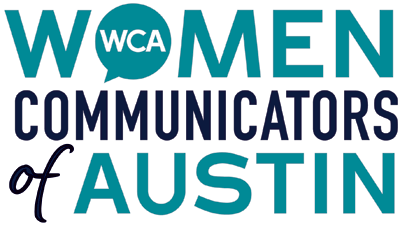In the nonprofit world, branding often takes a back seat to serving the mission. However, branding is as important to nonprofits as it is to consumer-oriented companies. Your organization’s brand acts as a guide for how you communicate with donors, volunteers, media, and other organizations. It helps differentiate you from other mission-oriented groups serving your community or competing for donations. Unfortunately, nonprofits often lack the funding for large branding efforts.
Women Communicators of Austin (WCA) launched its free CommSquad webinar series to help resource-strapped organizations take the first steps toward tackling their communications challenges. The webinars provide education and advice that nonprofits and small communications organizations can use in developing their communications plans. In each episode of our webinar series, we talk with communications and marketing experts about how to tackle the most challenging aspects of building and implementing an effective communications plan.
In this two-part episode, Gail Gonzales, brand strategist and owner of Evolve Your Brand, and Elizabeth Green, communications director of Big Cities Health Coalition, discuss the importance of brand voice for nonprofit organizations. Part One focuses on defining what it means to establish a brand and the importance of engaging your leadership in the process of developing the brand voice of the organization. Part Two delves deeper into the various steps in the process of identifying and defining brand voice.
Branding is more than a logo
Branding is often confused with visual and graphical elements. But branding goes far beyond logos and colors. A well-defined brand provides clarity, focus, and direction on how to deliver on the promises the nonprofit has made to serve its community. It should reflect the organization’s mission, vision, purpose, and values. Ultimately, it impacts the way the organization communicates with the rest of the world.
Gail and Elizabeth advise that organizations should begin by defining their brand voice, which impacts communication inside and outside the organization. It helps humanize the brand by imparting aspects of a persona, such as personality and tone of voice, into everything from written communication to the way you answer the phone.
“Nonprofits often haven’t put enough thought into their brand voice, how as an organization, they’re going to speak to the world,” Elizabeth said. “Brand voice is how you communicate who you are to the rest of the world.”
Your brand voice needs to reflect the values and persona that most strongly represents your organization’s mission and values. For example, your organization might identify as a hero, a caregiver, or a sage. Understanding the voice helps inform how you are supposed to speak when communicating on behalf of the organization.
Write it down
Create a written brand guide that is readily available to everyone in the organization. It should include examples of language and terms with phrases, paragraphs, and other copy that can quickly be dropped into documents, emails, newsletters, and other written materials produced by the organization. Make sure all the brand assets and resources are available in a central location, such as an internal website, so everyone within the organization can easily access the information they need.
Enlist executives as brand champions
The entire organization, including the executive leadership, needs to be involved in the branding process. This is not something that can be done in a silo. The executives should be brand champions rather than just leaving it all to the communications director.
“Executives need to prioritize the maintenance of your organization’s brand and not just leave it to the communications staff,” Elizabeth said. “The rest of your organization will look to you for what is considered important and if you leave the communications staff to be the brand police, it will feel like a negative experience for most of your staff.”
Finally, think about this as an evolving process. It doesn’t need to be perfect at the outset. Rather, think of your brand as a living, breathing thing. It’s not meant to be set in stone. Changes in public perception, shifting circumstances, and internal shakeups will impact your brand. You will need to reassess your brand voice every few years to make sure that it still serves your organization.
Watch the two-part episode to hear more advice from Gail and Elizabeth about how nonprofits can find and differentiate their brand voice. Then come back and check out the other CommSquad webinars.
- The 8 Pillars of Public Relations for Nonprofit Organizations - February 10, 2024
- Helping Nonprofits Find and Differentiate Their Brand Voice - February 1, 2024
- Comms Squad Webinar: Four Pillars of Creating a Communications Plan - October 13, 2022

